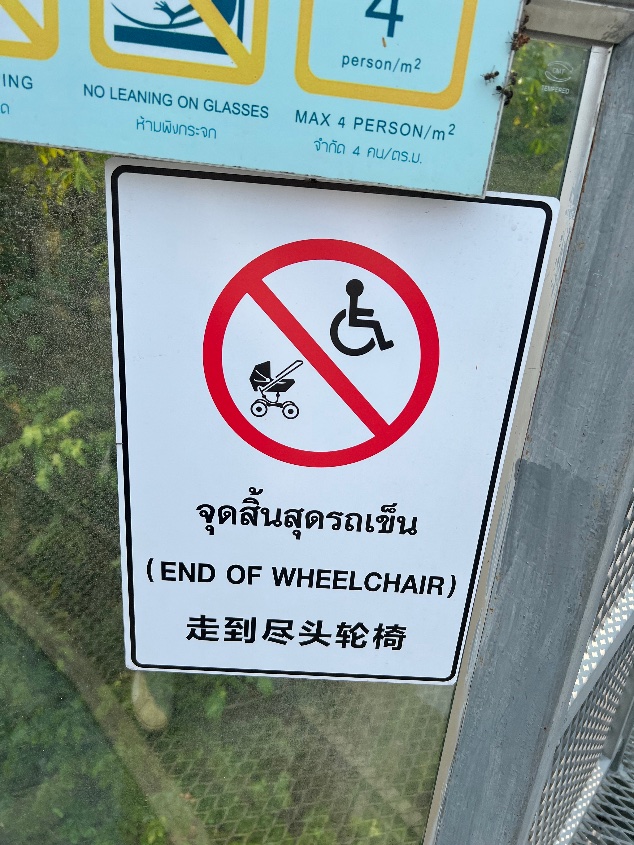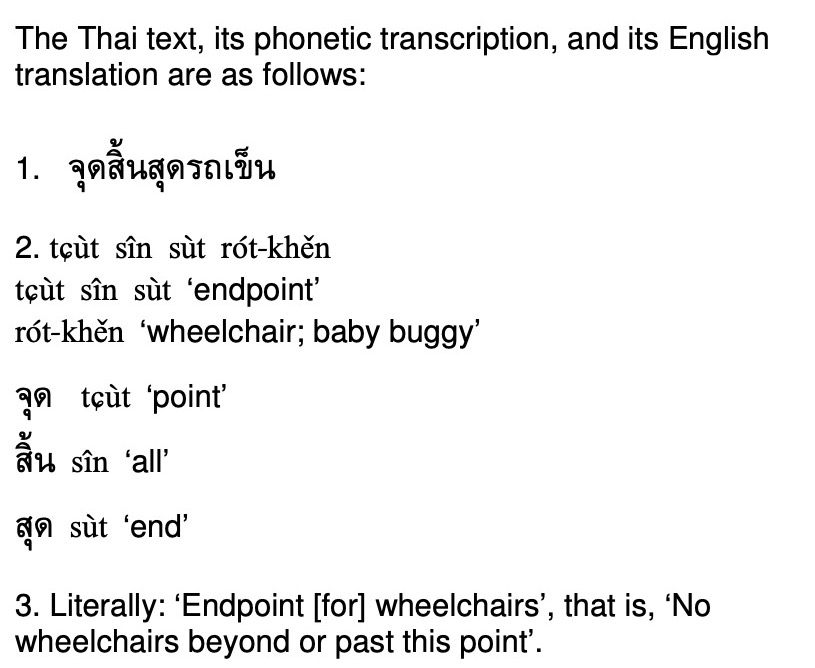Thailish, part 2
« previous post | next post »
Chiang mai, Thailand. On a trail in a botanical garden.
The Thai on the sign says:
tɕut sin sut rot kʰen
จุดสิ้นสุดรถเข็น
"end of wheelchair [pathway]"
The "pathway" is omitted in the Thai sign, so the English version is the literal translation of the sign.
More grammatically, the Chinese would say:
lúnyǐ dàolù de jìntóu
轮椅道路的尽头
"end of the wheelchair pathway"
or, more naturally:
lúnyǐ jìnzhǐ qián xíng
轮椅禁止前行
"wheelchairs are prohibited from proceeding forward"
Detailed explication of the Thai text from Bob Bauer:
Selected readings
- "Thailish" (10/15/15)
- "Mixed Thai, English, and Chinese sign" (4/11/23)
[Thanks to Zihan Guo and Pattira Thaithosaeng]


Taylor, Philip said,
April 16, 2023 @ 2:05 pm
Is "pathway" really implied ? Were I to read (in English) "End of wheelchair pathway", I would assume that (were I were using a wheelchair), I should expect the track to become uneven and that if I proceed, I do so at my own risk. I would not assume that I was prohibited from proceeding further. Thus I infer that จุดสิ้นสุดรถเข็น translates more as "End of wheelchair [access]" rather than "End of wheelchair [pathway]".
Howard said,
April 16, 2023 @ 4:50 pm
I am intrigued by these "NO Signs". I have a collection of hundreds of them. They fall into two categories, without or with accompanying text. To be effective, those in the first category need to be understood by almost everyone who will encounter them. If that doesn't happen, either because the graphic fails to invoke a widely held concept or because it refers to a concept known only to a few, then it fails. This leads to the second category, as here. In this group sometimes the graphic is an illustration to accompany the text, other times the text is to explain an ambiguous graphic. Here I think the intent is the latter. The graphic implies that the wheeled vehicles may not enter, not that the path is unsuitable or risky to use. One could ask why the graphic is there? Does it add something for illiterates or non-readers of the language(s) on the sign? By this criterion the sign fails and the graphic only adds ambiguity. I am but a hobbyist with this. Is there a literature on the use of these signs?
kmh said,
April 16, 2023 @ 7:06 pm
The Thai text just indicates that this spot (จุด) is the end (สิ้นสุด) for "push carts" (รถเข็น); for comparison, the "NO LEANING ON GLASSES" sign visible above in the picture begins with "ห้าม" ("it is forbidden to"), which is not part of the wheelchair sign.
Jonathan Smith said,
April 16, 2023 @ 8:14 pm
Dictionaries suggest the more relevant parse i.e. the compound per se is jootL + sinF-sootL i.e. 'point' + 'end'
Chas Belov said,
April 17, 2023 @ 12:39 am
There is also the matter that there is a baby buggy — a.k.a. pram for you folks east of the pond – in the graphic which is not mirrored in the text.
Tim Leonard said,
April 17, 2023 @ 1:25 pm
I'm amused by the "NO LEANING ON GLASSES," since I've occasionally suffered the unfortunate consequences of doing so.
Taylor, Philip said,
April 17, 2023 @ 1:40 pm
Chas, I don't think it qualifies as a pram (or a perambulator, for those of us old enough to remember the real name) — with a pram (of which the classic Silver Cross is surely the finest exemplar), the handles emerge from the rear of the pram, initially rising at an angle of some ${60}^{o}$ and then curving until they are more-or-less parallel to the ground. The device illustrated is, I think, very definitely a "baby buggy" or perhaps even a "stroller", regardless of one's place of birth or residence …
Kate Bunting said,
April 19, 2023 @ 8:44 am
In my (UK) youth they were 'pushchairs'. The first time I encountered the American term 'stroller' – in a reference to an exhibition where 'strollers were not allowed' – I thought it meant that you were obliged to walk round quickly!
Kate Bunting said,
April 19, 2023 @ 8:46 am
Looking again at the picture, though, I would call that a pram because the baby would be lying down, not sitting.
Scott P. said,
April 22, 2023 @ 10:43 am
Does the 'rot' part of 'rot kʰen' have the same root as Latin rota "wheel"?
kmh said,
April 22, 2023 @ 1:42 pm
This is the etymology in Wiktionary (https://en.wiktionary.org/wiki/%E0%B8%A3%E0%B8%96):
"From Pali ratha (“chariot”), from Sanskrit रथ (ratha, “idem”), possibly via Old Khmer ratha (“chariot; cart; wagon”). Cognate with Modern Khmer រថ (rŭət); Lao ລົດ (lot), ຣົຖ (rot); Lü ᦷᦟᧆ (lod)."
Here's the American Heritage Dictionary Indo-European Root entry for "ret-" meaning "to run, roll" (https://www.ahdictionary.com/word/indoeurop.html#IR091000):
"1. Prefixed Celtic form *to-wo-ret‑, "a running up to" (to‑, to; wo, under, up, up from under; see upo). Tory, from Old Irish tóir, pursuit.
2. Suffixed o-grade form *rot-ā‑. rodeo, roll, rota, rotary, rotate, rotund, rotunda, roulette, round1, rowel; barouche, control, prune2, rocambole, rotavirus, rotaxane, rotiform, rotogravure, from Latin rota, wheel.
3. Suffixed (participial) form *ret-ondo‑. rotund, rotunda, round1, from Latin rotundus, round, probably from *retundus, "rolling.".
[Pokorny ret(h)‑ 866.] "